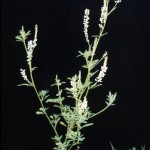Sweetclover
Melilotus spp.
Fabaceae (Legume family)
Description
There are three species of sweetclover in Texas. They are biennial or annual with erect, branching stalks 1 to 8 feet high. The alternate leaves have three egg-shaped leaflets with toothed margins on the tip. Small white or yellow flowers are presented in upright terminal spikes. Crushed plants have a characteristic sickly sweet, sharp odor.
Habitat
Sweetclovers are grown throughout the mid- and southwestern United States as highyielding, high-quality cultivated forage crops. Most areas in the eastern two-thirds of Texas can grow sweetclover without irrigation. Wild plants typically grow in areas that receive extra moisture such as draws, roadsides, and stock tanks.
Toxic Agent
Sweetclover contains coumarin, which may be converted to the toxin dicoumarol by bacteria or fungi in damaged plants, moldy hay and spoiled silage. The popularity of round-baled hay has almost eliminated the use of sweetclover, as a moldy thatch covers most bales. Dicoumarol disrupts normal blood clotting processes, causing internal and external hemorrhaging. Hay containing 0.002 to 0.003 percent dicoumarol may poison cattle. Feeding trials with sheep have shown them to be about twice as tolerant.
Signs of Livestock Ingestion
Clinical signs of poisoning vary depending upon the dicoumarol concentrations and the length of exposure. Signs can appear suddenly or after several months and include: Stiffness and lameness; Soft swelling under the skin; Nosebleeds; Anemia; Convulsions; Sudden death.
In several instances when cows have eaten sweetclover hay, the cows and/or their newborn calves have bled to death soon after parturation.
Management Strategies
Forage containing sweetclover should be baled only in small square bales after it is well-cured, and should not be fed if it is the least bit moldy. Chemical testing for dicoumarol in hay or silage is impractical because of difficulty in sampling. Treat poisoned animals with vitamin K and eliminate sweetclover from their diet.
Images
Plant Characteristics
Flower Color: White, Yellow
Seed Type: Bean/Pod
Duration: Annual, Biennual
Stem Texture: Hairless/Smooth
Growth Habit: Forbs/Broadleaf
Leaf Shape
 : Palmately Compound
: Palmately Compound
Season: Warm
Distribution
 : 01 - Pineywoods, 02 - Gulf Prairies and Marshes, 03 - Post Oak Savannah, 04 - Blackland Prairies, 05 - Cross Timbers and Prairies, 06 - South Texas Plains, 07 - Edwards Plateau, 08 - Rolling Plains, 09 - High Plains, 10 - Trans-Pecos
: 01 - Pineywoods, 02 - Gulf Prairies and Marshes, 03 - Post Oak Savannah, 04 - Blackland Prairies, 05 - Cross Timbers and Prairies, 06 - South Texas Plains, 07 - Edwards Plateau, 08 - Rolling Plains, 09 - High Plains, 10 - Trans-Pecos
Distributions
Distribution refers to the ecological region in Texas that a plant has been found. You can also view a clickable map.
Book: Toxic Plants of Texas (B-6105)
Collection: Toxics, Wild Flowers
Livestock Affected: Cattle, Goats, Horses, Sheep
Livestock Signs: Convulsions, Stiffness, Sudden Death






